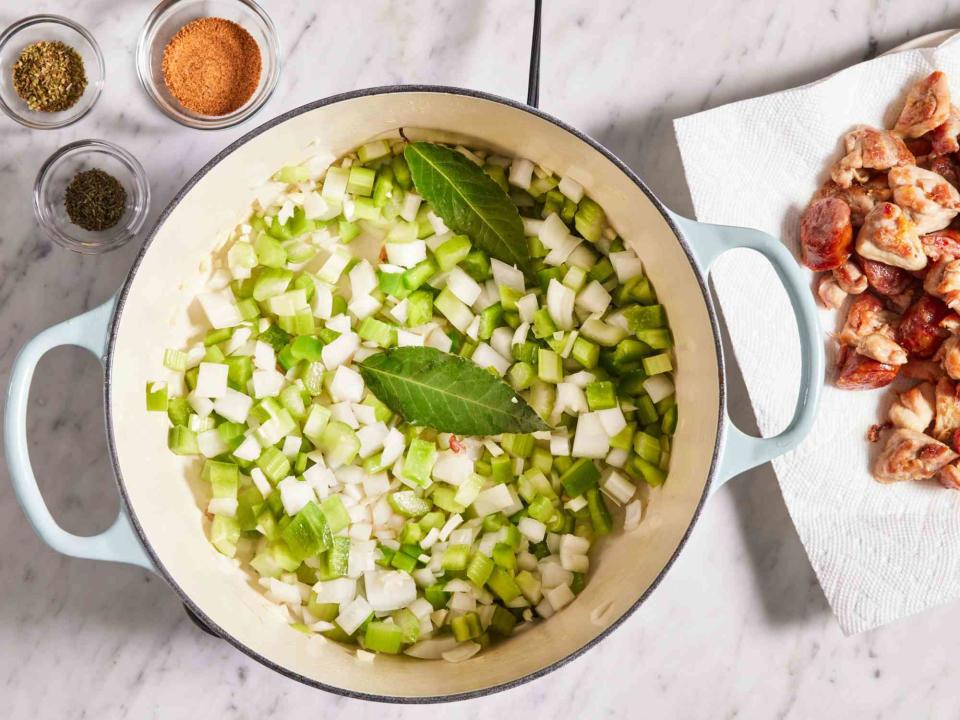What Is The Holy Trinity Of Cajun And Creole Cooking?
Three basic ingredients are essential.

You might not know it by name, but chances are you are familiar with the Holy Trinity of cooking if you've ever made a pot of gumbo. This backbone of Cajun and Creole cooking is essential for nailing the flavors and cuisine of Louisiana. It also has a rich history, connected to the different groups of people who settled in the region.
Dive into the Holy Trinity with us—the simple, but important starting point for some of the South’s most iconic dishes.
What Is The Holy Trinity?
Maybe you’re familiar with mirepoix, the combination of celery, carrots, and onions that make up the base of most French dishes from soups to sauces. The Holy Trinity is the Cajun and Creole counterpart to this trio, consisting of onion, celery, and rather than carrot, green bell peppers.
Just like mirepoix, the Holy Trinity is one of the first things to hit the pan, acting as an aromatic base for dishes like Gumbo, Jambalaya, and Crawfish Étouffée.
Why Is It Called 'The Holy Trinity'?
It’s hard to say who exactly coined the term, but many credit the ubiquity of this term to legendary chef Paul Prudhomme, who helped popularize Cajun and Creole cuisine through his cookbooks, food products, and restaurant, K-Paul's Louisiana Kitchen.
The name is an allusion to the Catholic Holy Trinity, the faith of some of Louisiana's earliest settlers, the Acadians. In the Catholic faith, the Trinity is made up of the Father, Son, and Holy Ghost, and these three divine entities are all part of one God. Similarly, in Creole and Cajun cuisine, the onion, celery, and green bell pepper are three parts of a single flavorful base.
The Holy Trinity in cooking is also often called The Cajun Trinity or The Holy Trinity of Cajun Cooking. That said, it is often used in both Creole and Cajun dishes.
Why Does The Holy Trinity Include Green Bell Peppers?
There are a few theories as to why the trifecta includes green bell peppers. Some say that the mild taste of a green bell pepper is preferred over sweeter carrots in Louisiana. Some lore says that green bell peppers were chosen as they grow better in Louisiana soil than carrots (which isn't really true).
According to the LSU College of Agriculture, there might be another reason: Bell peppers originated in the Americas, while carrots originated in Europe. This is important because that means carrots weren't cultivated in the U.S. until later, some time after English settlers arrived in Jamestown. Louisiana’s original French and Spanish settlers were familiar with onion and celery, but because carrots might not have been readily available, they substituted bell peppers that were indigenous to the area.
How To Make The Holy Trinity
All you need to make the Holy Trinity is a sharp knife and a few pantry basics. Unlike mirepoix, the ratio for the three counterparts is an even 1:1:1 split, although some chefs like to throw in extra onion. You can eyeball roughly equal quantities of each, as you don’t have to be too precise with this recipe.
Here are the basic steps for making your own batch of the Holy Trinity:
Peel and remove the top of 1 medium onion. With the root end still attached, cut it into ½-inch pieces.
Wash and remove the stem and seeds from 1 medium green bell pepper. Cut into ½-inch pieces.
Wash and trim the ends of 2-3 large stalks of celery. Cut stalks into ½-inch pieces. Note: For blended soups and stocks you can chop all of the vegetables into larger pieces, anywhere from 1-2 inches.
In a large skillet, melt 2 tablespoons unsalted butter over medium heat; once melted, add vegetables. Adjust the heat to medium-low and cook, stirring occasionally, until vegetables are soft, but not browned, about 10 minutes.
Now you have a flavorful base that’s ready to build upon—it’s up to you to decide where to take it from here.
For more Southern Living news, make sure to sign up for our newsletter!
Read the original article on Southern Living.

